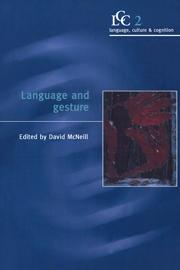Book contents
- Frontmatter
- Contents
- Acknowledgments
- Introduction
- Part 1 Gesture in action
- Part 2 Gesture in thought
- Part 3 Modeling gesture performance
- 13 Lexical gestures and lexical access: a process model
- 14 The production of gesture and speech
- 15 Catchments and contexts: non-modular factors in speech and gesture production
- Part 4 From gesture to sign
- Index
13 - Lexical gestures and lexical access: a process model
Published online by Cambridge University Press: 07 January 2010
- Frontmatter
- Contents
- Acknowledgments
- Introduction
- Part 1 Gesture in action
- Part 2 Gesture in thought
- Part 3 Modeling gesture performance
- 13 Lexical gestures and lexical access: a process model
- 14 The production of gesture and speech
- 15 Catchments and contexts: non-modular factors in speech and gesture production
- Part 4 From gesture to sign
- Index
Summary
Introduction
Observers of human behavior have long been fascinated by the gestures that accompany speech, and by the contributions to communication they purportedly make. Yet, despite this long-standing fascination, remarkably little about such gestures is well understood. The list of things we don't understand is long, but some of the most important open questions concern their form and function: Why do different gestures take the particular form they do, and What is it that these ubiquitous behaviors accomplish? Traditionally, answers to the function question have focused on the communicative value of gesture, and that view is at least implicit in most contemporary thinking on the topic. Although we do not question the idea that gestures can play a role in communication, we believe that their contribution to communication has been overstated, and that the assumption that communication is gesture's only (or even primary) function has impeded progress in understanding the process by which they are generated.
Ourgoal in this chapter is to provide a partial answer to the question of the origin and function of gesture. It is a partial answer because we suspect that different kinds of gestures have different origins and serve different functions, and the model we propose attempts to account neither for all gestural behavior nor for all of the functions gestures serve. Our account also must be regarded as tentative, because formulating a model requires us to make a number of assumptions for which we lack substantial empirical warrant.
- Type
- Chapter
- Information
- Language and Gesture , pp. 261 - 283Publisher: Cambridge University PressPrint publication year: 2000
- 225
- Cited by



